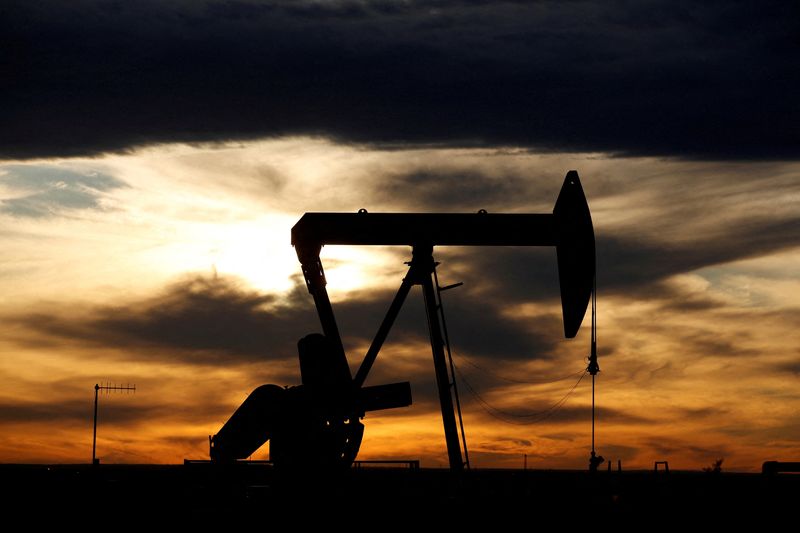

© Reuters. FILE PHOTO: The sun sets behind a crude oil pump jack on a drill pad in the Permian Basin in Loving County, Texas, U.S. November 24, 2019. REUTERS/Angus Mordant
By Florence Tan and Muyu Xu
SINGAPORE (Reuters) -Oil rose on Monday as the prospect of demand recovery, led by China’s loosening of COVID-19 curbs and the United States’ decision to buy back oil for its state reserves, gained the upper hand over global recession fears.
futures gained 42 cents, or 0.5%, to $79.46 a barrel by 0753 GMT while U.S. West Texas Intermediate crude was at $74.67, up 38 cents, or 0.5%.
Both benchmarks plunged more than $2 a barrel last Friday, following hawkish remarks from U.S. and European central banks on interest rate hikes that sparked worries of possible recession.
China, the world’s top importer and No. 2 oil consumer, is experiencing its first of three expected waves of COVID-19 cases after Beijing relaxed mobility restrictions.
“Despite a surge in COVID cases, the reopening optimism and accommodative policy improve oil’s demand outlook,” CMC Markets analyst Tina Teng said.
China’s abrupt end to its “dynamic zero” COVID policy is breathing new life into its ailing aviation sector, with average jet fuel demand jumping by 75%, or nearly 170,000 barrels per day, in two weeks, according to satellite data firm Kayrros.
On Friday, news outlet Caixin reported that China plans to increase flights with a goal to restore the country’s average daily passenger flight volumes to 70% of 2019 levels by Jan. 6.
“The market will focus on the progress of demand resumption in China…the general outlook is positive but the path of recovery could be slow and bumpy given the severe COVID situation in the near term,” analysts from Haitong Futures said.
China also pledged to focus on stabilising its $17-trillion economy in 2023 and step up policy adjustments to ensure key targets are hit, said its top leaders and policymakers at a closed-door two-day meeting for charting the economy’s course next year.
“The main tools for growth will be fiscal stimulus and stable monetary policies. We expect there will be a fiscal deficit of around 8% of GDP next year,” said Iris Pang, chief economist of Greater China at ING Bank.
Analysts from Morgan Stanley (NYSE:) believe a faster and sharper rise in mobility implies a stronger rebound in GDP growth starting in the early second quarter of 2023.
“In view of a faster rebound in economic activity, sustained at higher levels for longer, we now lift our 2023 GDP growth forecast from 5% to 5.4%, bringing it even higher than the consensus expectation of 4.8%,” they said in a note on Monday.
An announcement by the U.S. Energy Department on Friday that it will begin repurchasing crude oil for the Strategic Petroleum Reserve for delivery in February next year also supported the outlook for stronger prices.
This will be the United States’ first purchase since this year’s record 180 million barrel release from the stockpile.






